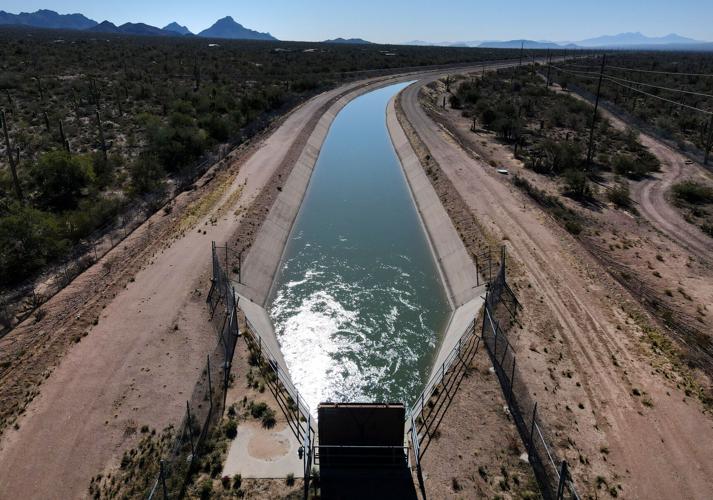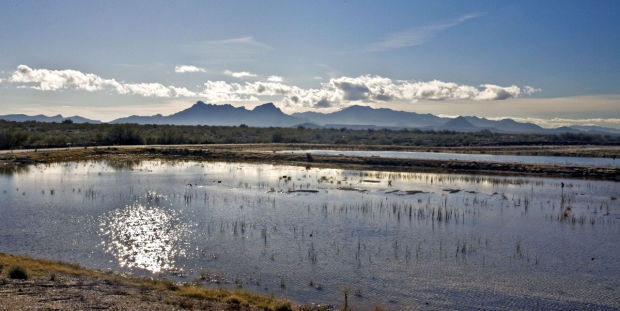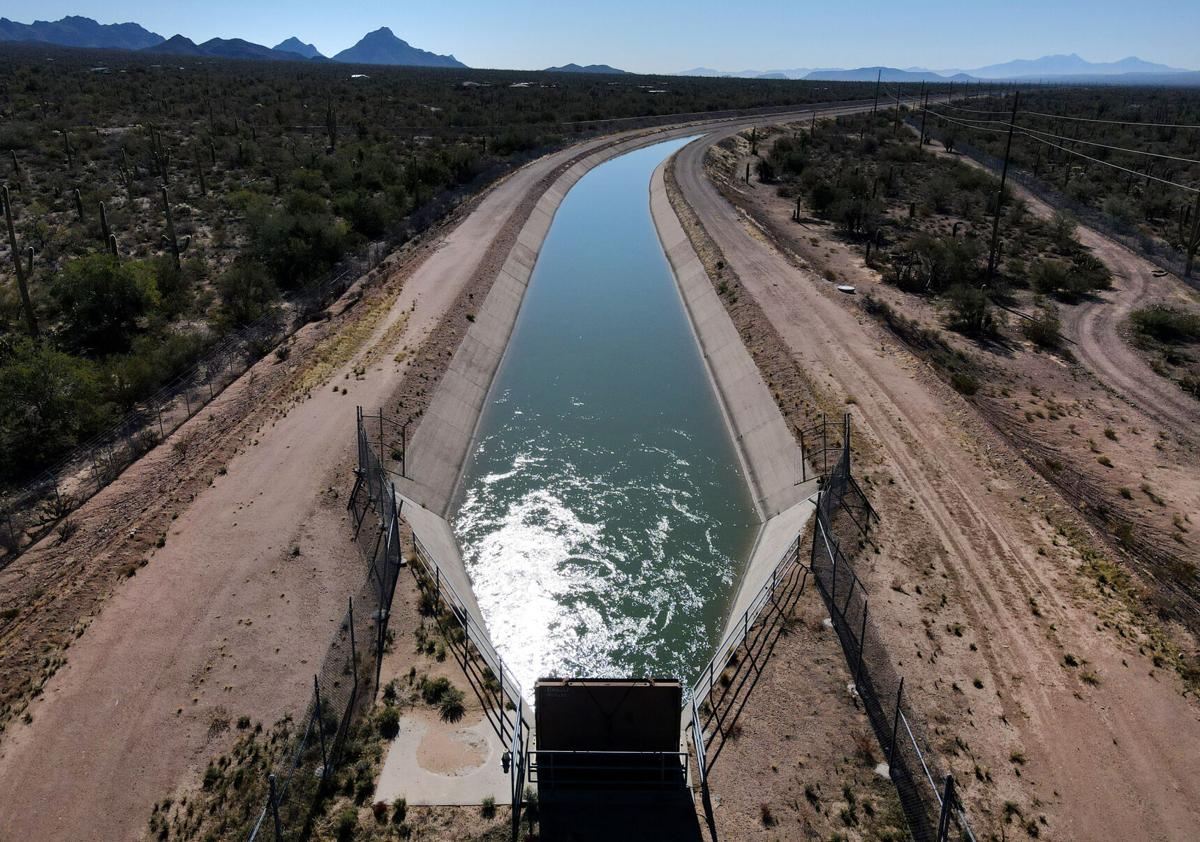Tucson Water officials are warning that severe cuts in the amount of CAP deliveries the city gets from the Colorado River could start next year, as federal officials seek to slice water uses across the entire river basin to protect its biggest reservoirs.
“Because of the dire conditions in Lake Mead and Lake Powell, any degree of reductions may be possible,” Tucson Water Director John Kmiec said Thursday in an email to the Star.
At some point, the cuts could be large enough that the city will have to pump native groundwater to serve to customers in greater proportions than it’s done since its heavy use of Colorado River water began more than a decade ago.
Kmiec’s comments came after Bureau of Reclamation Commissioner Camille Touton told a Senate committee Tuesday that the bureau wants the seven river basin states, including Arizona, to slash their take of river water by 2 million to 4 million acre-feet a year starting next year.
That’s about two to four times more water than the Central Arizona Project is scheduled to deliver to Tucson, Phoenix, numerous other cities and a host of tribes this year.
The purpose would be to insure that Mead and Powell don’t fall so low that they can no longer deliver water and generate electricity.
Touton said she wants an agreement among the basin states to apportion the cuts by mid-August, or the Interior Department will impose cuts — an action she said federal officials don’t want to do.
If no action is taken and natural river flows run less than 50% of normal the next four years, Lake Mead could reach “dead pool” — the level at which no water can be removed from it — in 2025 and 2026, according to slides presented by bureau scientist James Prairie on Thursday at a Colorado River conference in Boulder, Colorado.
“The situation on the river is not good. We may have to participate in severe cuts to our allocation as soon as 2023,” Kmiec told the Star.
Tucson has long been in the catbird’s seat for CAP water compared to other Arizona cities. Not only is its annual supply of 144,000 acre-feet one of the largest of any Arizona city, it’s enough that Tucson doesn’t need to use about 30% of it every year. Instead, it stores it underground for future use.

Recharge basins in the Avra Valley are among sites where CAP water is stored underground. The underground CAP supplies would provide about five years worth of water citywide if no other water was used.
The underground CAP supplies would provide about five years worth of water citywide if no other water was used. If major CAP cuts kick in, the stored water could fill the gap between what Tucson gets each year from the CAP canal, and what the community uses each year, Kmiec said.
Phoenix-area cities that get CAP also will be targets for cuts under the Bureau of Reclamation’s new directive. But Warren Tenney, who runs a 10-city, Phoenix-area water users association, declined to speculate on how significantly those cities would be affected, because “I don’t want that kind of information used in negotiations.”
“Well, certainly it would be a serious impact, whatever the percentage of cut it might be. But I’m hesitant to say whether we can handle it or not. I don’t want that to be used against us,” said Tenney, general manager of the Arizona Municipal Water Users Association. It represents Phoenix and nine other cities with 3.7 million people total.
City leaders point to farms
Led by Las Vegas-area water officials, many urban leaders have noted that agriculture slurps 75% to 80% of all water used in the entire Colorado River basin, and have said cities can’t possibly save enough water to account for all the needed cuts.
But while many cities, like Tucson, have other water supplies they can turn to in an emergency in which CAP water disappears or is cut drastically, farms often have nowhere else to turn if they lose river supplies.
While many water officials say the farms could save a lot of water by replacing thirsty flood irrigation methods with water-saving drip irrigation, or by growing fewer water-guzzling crops, such big changes can’t be made by early next year, agricultural community leaders told the Star.
A possible alternative could be temporary, large-scale fallowing of crops. But farming leaders say that could have major economic consequences both for farmers and for the surrounding communities whose economies depend on them.
No silver bullet, only buckshot
Overall, “There’s no silver bullet” for the basin’s problems, said Kathryn Sorensen, an Arizona State University water researcher and former water director for Phoenix, at the Boulder water conference Thursday. “There’s only buckshot left and we’re all going to get splattered.”
Sorensen told the Star that of those attending the conference she’s talked to, “There is broad recognition of how dire the situation is and determination to do what needs to be done.”
“I think it will be a big shock to the system,” said former U.S. Assistant Interior Secretary Anne Castle of Reclamation’s demand for such a big cut so quickly. “In a sense, the water use shock is just catching up with the hydrological shock that has been occurring for the last 20 years.”
Reclamation’s demands basically require a recalculation of all priorities of who gets how much water, as laid out by the century-old Colorado River Compact, said CAP Board President Terry Goddard.
The commissioner’s request for up to 4 million acre-foot savings came as the CAP was already expecting to take more significant cuts in 2023 and 2024 than it did this year, Goddard said.
“It’s obviously a complete change in our perspective in how much water the river can provide,” he said.
If the basin’s weather stays as dry as it’s been the past couple of years, that will force radical changes in water use across the entire West, said Bill Hasencamp, manager of Colorado River programs for Southern California’s six-county Metropolitan Water District.
“Obviously with outdoor watering and lawns in particular, there could be a complete ban on outdoor use. Nevada is doing it and it may be the future,” said Hasencamp.
Speaking from the Boulder water conference, he added, “I’m here at the University of Colorado, looking at all the grass and it looks gorgeous. Maybe in the future, that’s a luxury we can’t afford.”
Grim outlook from Reclamation
At that conference, Reclamation’s Prairie presented a series of slides raising a grim outlook for the reservoirs to explain why bureau officials believe the big water use curbs are needed.
The bureau’s goals are to keep Mead at 1,000 or 1,020 feet in elevation and Powell at 3,500 or 3,525 feet.
At 1,000 feet, Mead would be 50 feet above the level at which Hoover Dam could no longer generate power. For Powell, 3,525 is 35 feet above the level at which Glen Canyon Dam couldn’t generate power.
The slides said:
Mead would land at or very near “dead pool” in 2025 and 2026 if annual flows fall below 50% of normal in 2024 through 2026. At “dead pool,” no water could be extracted.
If flows fell below 50% of normal those years, Powell would fall well below 3,490 in all four, and near 3,400 feet in 2024 through 2026. “Dead pool” for Powell is 3,370 feet.
“Even with a good year, we can quickly be back in the same position we are in today, or worse,” one slide said.
CAP has lower priority than California
In Arizona, the biggest concern by far is how a cut of up to 4 million acre-feet will affect CAP.
As a condition for getting Congress to authorize the $4 billion water project in 1968, Arizona officials had to accept “junior priority” status, compared to politically powerful California.
Under the law, when water shortages occur on the river, the CAP must give up all of its supply before California loses any of its 4.4 million acre-feet.
“As a current junior rights member in the lower basin, this has always been a concern. Arizona’s economy and importance to the nation has changed much since 1968,” Tucson Water’s Kmiec said. “Our desire is that the increased national importance of the state of Arizona will be a factor in how the future allocations will be made.”
The Star asked about possible CAP cutoff in conversations with water experts in both basins — Castle, now a University of Colorado research fellow; author and former Colorado water official Eric Kuhn; and Sarah Porter, director of Arizona State University’s Kyl Water Policy Center. They agreed CAP is unlikely to get wiped out.
How to deal with CAP’s low priority is one of several “equity” issues the state’s water officials are struggling to deal with, Castle said.
Another is the importance of tribal water rights.
A third is caused by the fact that the Upper Basin stands to lose a lot of water if Lake Powell falls so low that it can’t deliver enough over a decade to meet is obligations to the Lower Basin set by the 1922 Colorado River compact — even though the Lower Basin uses twice a much water as the Upper Basin.
Public health and safety issues will also play into decisions affecting CAP, Porter said, since Arizona cities rely on CAP water for health and safety reasons.
“Cities remaining functional, having enough water to do so is a priority,” she said.
But Porter and Goddard agreed that continuing to provide Tucson enough CAP water to recharge 30% of it for future use, as it does now, will not be a major priority.
“It does make sense that cities will not be having delivered water they’re just using for recharge,” Porter said.
The CAP has already cut its take of water from the river by about one-third since the three Lower Basin states of Arizona, Nevada and California signed the basin’s drought contingency plan in 2019. Just in 2022, the project lost 512,000 acre-feet, most of which fell upon a group of Pinal County farmers.
Kuhn predicted CAP will have to take a very significant cut, in the range of 800,000 to 900,000 acre-feet from its original supply of 1.5 million a year.
“It seems to me when they modeled the project’s supplies in the ’60s, they showed lots of years when CAP got nothing. They had lots of years when CAP got lots of water, but lots of years when they got nothing,” said Kuhn, retired general manager of the Colorado River District in Glenwood Springs, Colorado.
He added, “Politically, I think it’s not going to happen” that CAP will ever get nothing.
Goddard, the CAP board president, however, said he intends to push hard for the project to continue to get 900,000 acre-feet a year. Tucson and other cities get about 440,000 acre-feet of CAP each year, while tribes get 520,000, he said.
Under the 2019 Lower Basin drought contingency plan, Arizona agreed to give up 720,000 acre-feet a year when Lake Mead drops to 1,025 feet, the lowest elevation that plan considers, and about 600,000 of that cut would come from the CAP, he noted. Last year, Arizona left 800,000 acre-feet in the lake, with most coming from the CAP, he said.
“We’ve given heavily and who else has given? There will be a little bit coming from Nevada and 300,000 acre=feet coming from California under the DCP (drought contingency plan). But what’s happened in the Upper Basin? They haven’t cut anything,” Goddard said.
The Upper Basin states are Colorado, New Mexico, Utah and Wyoming.
California officials’ reaction
In interviews, California water officials sound somewhat amenable to deviating from the 1968 CAP law in deciding who takes the biggest share of cuts, while paying homage to the priority system that favors them.
“We have 100 years of working collaboratively on the river. We’ve had some litigation. We’re all hoping that we can come with an equitable plan that will keep us around the table and out of the courts,” said Peter Nelson, who chairs the Colorado River Board of California. It represents the state in interstate negotiations over the river.
“We want to come up with a collective, collaborative solution in light of the priority system, and in light of those who are holding their priorities very dear to their hearts — the people with the senior priority rights,” Nelson said.
Hasencamp of the Metropolitan Water District said, “I would say everyone should be nervous if we don’t reach consensus.”
If the states can’t reach agreement, there are a number of ways the feds could then act, perhaps by strictly following legal priorities or by giving urban areas preference over rural areas, for instance, he said.
Bart Fisher, a board member and former president of Southern California’s Palo Verde Irrigation District, said he has no idea where the Arizona-California issue will lead, “but I suspect when you put us all in the room, we’re probably going to reach the best compromise possible under the circumstances.”
“I will say we have the Law of the River: the 1922 Colorado River Compact, the Supreme Court ruling for Arizona versus California, the 2007 operating guidelines for the reservoirs and the 1968 CAP law. I think that to the maximum extent possible we adhere to the existing legal system, the better it will be for finding long-term solutions. If we deviate from the Law of the River, what’s the point of the Law of the River?” he said.
Hasencamp said he doesn’t just want to focus on who takes the cuts.
“I’d like to find a creative way to minimize the pain. Are there augmentation opportunities? Are there opportunities to switch agriculture to crops that use less water? Let’s at least have those discussions to see what possibilities there are.
“The changes are going to be painful for a period of years, and I don’t think we’ll ever get back to using 7.5 million acre-feet a year, ever,” Hasencamp said, referring to the Lower Basin’s legal share of river water.
“We’re going to have a permanent shortage. But hopefully, we will look back in 20 years and say it was a painful process but we got through it.”







